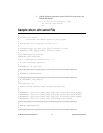
© National Instruments Corporation 15 Using PCI Serial with Linux
linux# ./rs485 <
transmit port number
> 0
linux# ./rs485 <
receive port number
> 0
linux# ./serialtest <
receive port number
> <
transmit port
number
>
What do I do if my ports are not communicating correctly and print
strange characters?
Make sure the baud rate, character size, clock speed (if PCI-485) and parity
are the same for both the receiver and transmitter. Also make sure the
transceiver modes (PCI-485) have been selected for both transceivers.
How can I use
/dev/ttyS0, /dev/ttyS1, /dev/ttyS2, or
/dev/ttyS3 as National Instruments serial ports?
Check for available serial devices by entering the following:
linux# setserial -gv /dev/ttyS*
/dev/ttyS0, UART: 16550A, Port: 0x03f8, IRQ: 4
/dev/ttyS1, UART: unknown, Port: 0x02f8, IRQ: 3
/dev/ttyS2, UART: unknown, Port: 0x03e8, IRQ: 4
/dev/ttyS3, UART: unknown, Port: 0x02e8, IRQ: 3
Devices labeled with UART: unknown are available for use. To designate
the available device when using
setserial, enter the following:
linux# setserial /dev/ttyS<
port number
> uart 16550a
port 0x<
port address
> irq <
irq
> ^fourport
Assign Driver
Use these instructions to automatically assign the driver at startup using
/etc/rc.d/rc.serial.
You should not change the
/etc/rc.d/rc.serial file until you have
your serial interfaces installed and configured. If you add another device or
interface to your computer, and your
lspci output changes, make sure you
also change
/etc/rc.d/rc.serial.
Depending on your Linux distribution, you might not have an
/etc/rc.d/
directory. In this case, your
rc.serial would be located under
/etc/rc.serial. If you do not have /etc/rc.d/, replace the references
to
/etc/rc.d/ with /etc/. If you are using a Debian distribution, replace
the references to
/etc/rc.d/rc.serial with
/etc/rc.boot/0setserial.


















